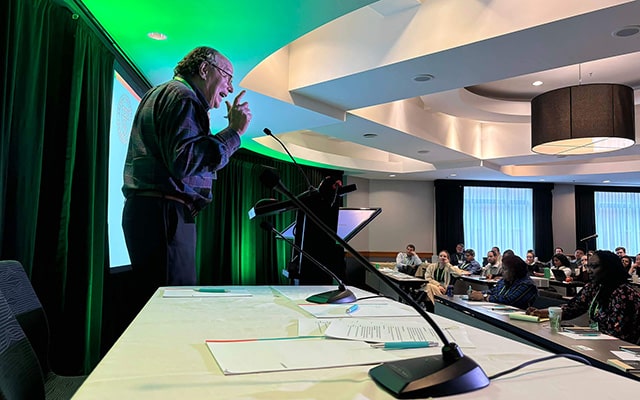By Bob Riter, Patient Advocate, Cornell Community Cancer Partnership
When I was diagnosed with stage 2 breast cancer about 27 years ago, I sought out information and support from the Ithaca Breast Cancer Alliance, and quickly found the power of connection. I became increasingly involved with the organization, eventually becoming the executive director after it had expanded its scope to serve patients with all types of cancer and changed its name to the Cancer Resource Center of the Finger Lakes.
After I retired from my role there in 2017, I have focused my advocacy on connecting cancer researchers with cancer patients and survivors. I am a graduate of the American Association for Cancer Research (AACR) ScientistSurvivor Program, which for 27 years has helped to build lasting partnerships among the scientific and patient communities. I have also had the privilege of being involved with the Cornell Community Cancer Partnership, which focuses on connecting graduate students in the basic sciences with cancer patients and other members of the local community. And I have seen how faculty members Bob Weiss, PhD, and Claudia Fischbach, PhD, have supported and nurtured this partnership program from the very beginning.
All of this is to say, I have firsthand experience with programs focused on connecting cancer researchers with patient advocates that are built to last. While several such programs exist—with most championed by a core of individuals who propose the idea, make connections, and organize initial activities—only some take root and become ongoing and established programs.
Bob speaking at the AACR Translational Cancer Research for Basic Scientists Workshop held October 6-11, 2024 in Cambridge, Massachusetts.
In addition to the AACR ScientistSurvivor Program and the Cornell Community Cancer Partnership, other examples of lasting programs include the Georgetown Breast Cancer Advocates, an established program that connects breast cancer researchers with patient advocates, and the Congressionally Directed Medical Research Programs, which actively engage advocates (known as consumers) throughout the research review process.
For programs that fail to become established with ongoing activities, the challenge that often emerges is: How do programs continue to evolve and prosper once the founders—the champions—move on and reduce their involvement? Programs need to be able to regenerate both leadership and participants. This is especially true in academia.
It’s reasonable to think that most programs at universities go through three phases:
Emergent: The “ad hoc” events that many universities hold from time to time. These can be sessions in which cancer patients describe their experiences to young researchers, or an opportunity for students to give lab tours and explain their research. Many of these programs are initiated by students.
Established: A program that provides ongoing opportunities to connect researchers and advocates. In a university setting, new graduate students are provided the chance to engage with advocates each year. The program is in place and available when students and researchers are ready to engage. A faculty member usually serves as the point person.
Regenerative: In academia, a regeneration of new students each year is only natural. But over time, new patient advocates and new faculty members will also need to be brought into these partnership activities. This is because faculty involvement in community activities may not be rewarded in tenure and promotion decisions, so it’s an “extra” duty for faculty members to maintain, causing them to leave the program. Similarly, programs often begin with a cadre of committed patients/survivors, but their interest, availability, and health may change from year to year.
The purpose of this blog post is to encourage university programs to begin thinking about a regenerative program from early in their development.
Creating Regenerative Patient Advocate Partnership Programs
The following suggestions are based on my experiences with programs that have proven their sustainability. While the focus is on university partnerships, these principles could be applied in other settings as well.
For starters, committed students not only bring enthusiasm, but they can do much of the leg work. Alex McGregor, PhD, and Peter DelNero, PhD, MPH, were instrumental in getting the program at Cornell off the ground when they were graduate students in 2017, and they previously wrote about their experiences. That’s why it is important to provide incentives to committed students like this for taking leadership roles each year, including travel support to present their research, opportunities to select guest speakers, etc.
Also, encourage faculty members to be involved on a rotating basis for time-limited terms, e.g., two years. For junior faculty, it can be part of their professional development and (hopefully) be rewarded in tenure decisions. Similarly, engage a “lead” advocate who’s well-connected in the patient community to encourage involvement from patients and survivors on an ongoing basis. Providing a stipend would be ideal, but even offering a desk and a sense of connection can go a long way.
But engaging with just one lead advocate is not enough. Partnering with patient support organizations in the community is the easiest way to recruit and communicate with patients and survivors. It can also help with grant funding. Writing a small proposal to support a partnership may be simpler if done under the umbrella of a small nonprofit as opposed to that of a large research university.
Finally, collaborate with other universities in your area. This is a natural way to connect young cancer researchers with each other and with the local cancer community. It also provides an opportunity to share the benefits and burdens of a partnership program.
It’s wonderful that many university programs that connect cancer researchers with patient advocates are maturing to the point of needing to think about the second and third generations of leadership, researchers, and advocates. Taking relatively simple and inexpensive steps can provide the renewal needed to ensure their future.
Bob Riter is the patient advocate of the Cornell Community Cancer Partnership. Bob began his career in health services administration but became active in the cancer world after he was diagnosed with breast cancer in 1996. He was later diagnosed with prostate cancer and was found to have a CHEK2 mutation. He was previously the executive director of the Cancer Resource Center of the Finger Lakes.
The post Connecting Cancer Researchers and Advocates: The Importance of Regeneration appeared first on American Association for Cancer Research (AACR).



